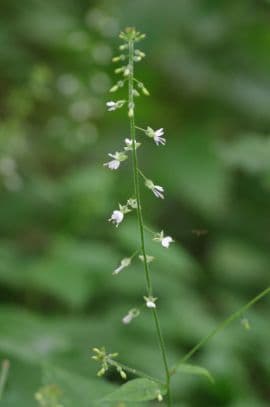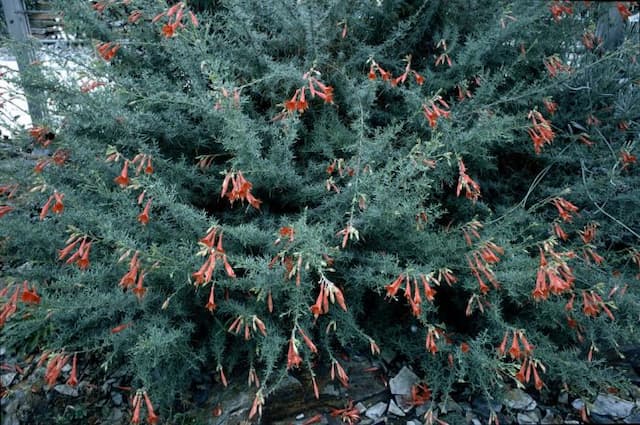Fuchsia Fuchsia 'Prosperity' (d)

ABOUT
Fuchsia 'Prosperity' is a charming plant known for its decorative and pendulous flowers. The blooms are particularly striking, featuring a beautiful combination of colors. Each flower is composed of an outer layer of large, petal-like structures that can range from a pale pink to a soft lilac hue. Enclosed by this layer is a striking corolla, which typically exhibits a deep purple or magenta color, creating a vibrant contrast against the paler outer petals. These corolla petals are long and slender, often gracefully curling at the ends, and they surround protruding stamens with delicate tips. The overall floral display is reminiscent of dainty ballerinas suspended in mid-air, giving the plant an elegant and whimsical appearance. The flowers are borne in clusters that dangle from the plant's gracefully arching branches, further adding to their ornamental value. The foliage of Fuchsia 'Prosperity' adds to its visual appeal, with leaves that are typically green with a subtle bluish tinge. These leaves are oval in shape, with softly serrated edges that are sometimes slightly ruffled. Together, the contrast between the lush green foliage and the striking multi-toned flowers creates a lush and lively display, making Fuchsia 'Prosperity' a popular choice among gardeners looking for plants that can provide a touch of sophistication and vibrant color to their gardens or hanging baskets.
About this plant
 Names
NamesFamily
Onagraceae
Synonyms
Lady's Eardrops, Fuchsia
Common names
Fuchsia 'Prosperity'.
 Toxicity
ToxicityTo humans
Fuchsia plants, including the variety 'Prosperity,' are generally considered non-toxic to humans. They are not known to cause serious illness when ingested. However, some individuals might have a mild stomach upset if they consume parts of the plant, as is the case with many ornamentals that are not intended for consumption.
To pets
Fuchsia plants are also considered non-toxic to pets such as dogs and cats. While they are not poisonous, ingestion may result in mild gastrointestinal discomfort in some animals. Symptoms from eating parts of the plant are usually not severe but can include vomiting or diarrhea. It's always best to discourage pets from nibbling on any household plants to avoid any potential issues.
 Characteristics
CharacteristicsLife cycle
Perennials
Foliage type
Deciduous
Color of leaves
Green
Flower color
Pink
Height
2-3 feet (0.6-0.9 meters)
Spread
2-4 feet (0.6-1.2 meters)
Plant type
Shrub
Hardiness zones
10
Native area
Central America
Benefits
 General Benefits
General Benefits- Aesthetic Appeal: Adds vibrant color and unique pendulous flowers to gardens and landscapes.
- Attracts Pollinators: Brings beneficial insects like bees and hummingbirds to the garden.
- Versatility: Can be grown in containers, hanging baskets, or in-ground, fitting various gardening styles.
- Long Blooming Season: Provides blooms from late spring to early autumn, maintaining garden interest.
- Shade Tolerance: Thrives in partial shade, making it suitable for garden spots that receive less sunlight.
- Low Maintenance: Requires minimal pruning and care once established.
- Non-Invasive: Unlike some ornamental plants, it is not known to be invasive and is safe for local ecosystems.
 Medical Properties
Medical PropertiesThis plant is not used for medical purposes.
 Air-purifying Qualities
Air-purifying QualitiesThis plant is not specifically known for air purifying qualities.
 Other Uses
Other Uses- The vivid blooms of fuchsias can be used to create natural dyes for fabrics, providing a range of pinks and purples depending on the mordant used.
- Fuchsia flowers can be crystallized with egg whites and sugar to create an edible garnish for cakes and pastries.
- The petals of fuchsia flowers can be used in potpourri mixtures for a decorative and subtly fragrant addition to a room.
- Fuchsia flowers can be incorporated into homemade syrups for flavoring cocktails, sodas, or desserts with their slightly acidic taste.
- The plant can be grown as a living barrier or privacy screen on patios or balconies due to its bushy growth habit.
- Fuchsia can be trained as a bonsai for an ornamental indoor display that showcases its miniature tree-like form.
- The striking flowers of the fuchsia can be used as inspiration for artists and designers in patterns and motifs for textiles or wallpaper.
- Dried fuchsia flowers can be used in crafting, such as in the creation of floral resin jewelry or decorative bookmarks.
- The shape and vibrant colors of fuchsia blooms make them suitable for use in pressed flower art, preserving their beauty in frames or glass displays.
- Fuchsia plants can be a source of nectar for hummingbird feeders, attracting these birds into the garden for observation and photography.
Interesting Facts
 Feng Shui
Feng ShuiThe Fuchsia is not used in Feng Shui practice.
 Zodiac Sign Compitability
Zodiac Sign CompitabilityThe Fuchsia is not used in astrology practice.
 Plant Symbolism
Plant Symbolism- Grace - Due to its elegant, drooping flowers, fuchsia often symbolizes grace under pressure, or handling situations with dignity.
- Mutual Understanding - Fuchsia blossoms can represent deep love and trust, conveying a sense of amity and connection between people.
- Confiding love - Its delicate and vibrant blooms are associated with a more confidential and profound expression of love.
- Gentility - Fuchsia's appearance is gentle and refined, making it symbolic of good manners and noble lineage.
- Prosperity - As the specific variety is named 'Prosperity', it suggests a wish for wealth, success, and general well-being.
 Water
WaterFuchsias, including Fuchsia 'Prosperity', require consistent moisture but should not be left waterlogged. Water them when the top of the soil feels dry to the touch, usually about two to three times a week, depending on the climate and indoor conditions. Use about 8-16 ounces of water for potted fuchsias each time, ensuring it's enough to moisten the soil but not so much that it's soggy. During high heat in summer, they may require daily watering, whereas in cooler temperatures, watering frequency should be reduced.
 Light
LightFuchsias, such as Fuchsia 'Prosperity', thrive in bright, indirect light. The best spot for the plant would be in an area where it can get morning sun and afternoon shade, or dappled sunlight throughout the day. They should be protected from the harsh, direct afternoon sunlight, which can scorch their leaves.
 Temperature
TemperatureFuchsia 'Prosperity' prefers temperatures between 55°F and 75°F. It can survive minimum temperatures down to about 40°F, but to thrive, it should not be exposed to conditions below this range. During the summer, ensure the plant is not subjected to temperatures above 80°F for extended periods, as this can stress the plant.
 Pruning
PruningPruning Fuchsia 'Prosperity' is crucial to encourage a bushy growth habit and abundant flowering. Prune in the late winter or early spring before new growth begins. Remove dead or weak branches and shape the plant as desired. Pruning can be done annually, with additional pinching back of the tips during the growing season to promote branching.
 Cleaning
CleaningAs needed
 Soil
SoilFuchsia 'Prosperity', commonly known as Fuchsia, thrives in well-draining soil with a mixture of peat, loam, and sand. A pH range of 6-7 is ideal for this plant to ensure nutrient availability and root health. Incorporating organic matter like compost or well-rotted manure can enhance soil fertility and structure, promoting vigorous growth.
 Repotting
RepottingFuchsia 'Prosperity', or common Fuchsia, should be repotted annually, preferably in the spring before new growth begins. Younger plants may require more frequent repotting, especially if they outgrow their containers, to ensure continued growth and flowering.
 Humidity & Misting
Humidity & MistingFuchsia 'Prosperity' prefers high humidity levels, ideally around 60-70%. To maintain these conditions for your Fuchsia, a humidifier or regular misting can help, especially in dry indoor environments or during the hotter months of the year.
 Suitable locations
Suitable locationsIndoor
Keep Fuchsia in bright, indirect light and high humidity.
Outdoor
Place Fuchsia in dappled shade and protect from frost.
Hardiness zone
9-11 USDA
 Life cycle
Life cycleFuchsia 'Prosperity' begins its life cycle when a seed germinates in moist, well-draining soil with partial shade to full sun exposure. The seedling stage ensues with the emergence of cotyledons followed by true leaves, as the plant establishes a root system and begins to photosynthesize. In the vegetative stage, the plant develops a bushy structure with woody stems and prolific leaf growth, which supports the forthcoming reproductive phase. Upon entering maturity, Fuchsia 'Prosperity' produces distinctive, pendulous flowers with an array of pink and purple hues typically from late spring to fall, attracting pollinators such as hummingbirds and bees. Following pollination, the flowers develop into small, oval fruit containing seeds, completing the reproductive cycle. The plant may enter a period of dormancy during colder months, reducing growth and conserving energy, to later resume its active growth cycle with the return of favorable conditions.
 Propogation
PropogationPropogation time
Spring-Early Summer
Fuchsia 'Prosperity', commonly simply referred to as Fuchsia, can be propagated effectively using softwood cuttings. The ideal time to take cuttings is during late spring to early summer when the plant is actively growing and the new growth is mature enough yet still soft. To propagate from softwood cuttings, one would first need to take a 3 to 5 inch (about 7.5 to 12.7 cm) length of stem that has a few leaves on it, making sure to cut just below a leaf node as this is where roots are most likely to form. The lower leaves should be removed and the cut end dipped in rooting hormone to encourage root development. The cutting can then be placed in a well-draining soil mix, ensuring that the leaf nodes where the lower leaves were removed are buried in the soil. The soil should be kept consistently moist but not waterlogged, and the cutting should be placed in indirect light until roots have developed, which typically takes about 3 to 4 weeks. Once the cutting has rooted, it can be transplanted to a larger pot or its final growing location.









